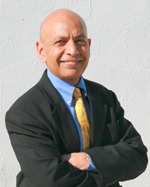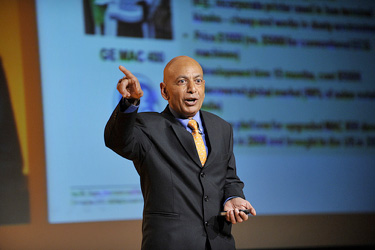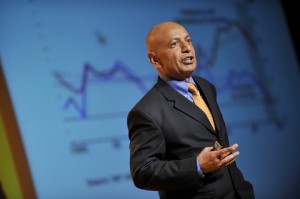![]()
 Anil Gupta
Anil Gupta
Global Strategy in the Age of China and India
 Dr. Anil K. Gupta is the Michael D. Dingman Chair in Strategy, Globalization and Entrepreneurship and Distinguished Scholar-Teacher at the Smith School of Business, The University of Maryland at College Park. Anil also serves as chairman, The China India Institute, a Washington DC-based research and consulting organization. He has earlier served as the INSEAD Chaired Professor in Strategy at INSEAD and a visiting professor at Stanford University as well as Dartmouth College. He received a doctorate from the Harvard Business School, an M.B.A. from the Indian Institute of Management at Ahmedabad, and a B.Tech. from the Indian Institute of Technology at Kanpur.
Dr. Anil K. Gupta is the Michael D. Dingman Chair in Strategy, Globalization and Entrepreneurship and Distinguished Scholar-Teacher at the Smith School of Business, The University of Maryland at College Park. Anil also serves as chairman, The China India Institute, a Washington DC-based research and consulting organization. He has earlier served as the INSEAD Chaired Professor in Strategy at INSEAD and a visiting professor at Stanford University as well as Dartmouth College. He received a doctorate from the Harvard Business School, an M.B.A. from the Indian Institute of Management at Ahmedabad, and a B.Tech. from the Indian Institute of Technology at Kanpur.
Anil is widely regarded as one of the world’s leading experts on strategy, globalization and entrepreneurship. Ranked by Thinkers50 as one of the world’s “most influential living management thinkers,” he has also been named by The Economist as one of the world’s “superstars” in a cover story on “Innovation in Emerging Economies.” He is one of only 3 professors in the world to have been elected by his peers as a Lifetime Fellow of all three of the most prestigious bodies in the field – Academy of Management, Strategic Management Society, and Academy of International Business, with a combined membership of over 25,000 scholars worldwide.
Anil’s other honors include the “Best Professor in Strategic Management” award from CMO Asia, recognition by BusinessWeek as an Outstanding Faculty in its Guide to the Best B-Schools, induction into the Academy of Management Journals’ Hall of Fame, and listing by Management International Review as a “North American Superstar” for research in strategy and organization. He is also a regular participant at the World Economic Forum summits including the annual meeting in Davos and the regional meetings in China, India, and the Middle East. He is also a member of the Forum’s Global Agenda Council on Emerging Multinationals.
1Day Master-Class on “Leveraging the Power of Strategy and Innovation”
Creating the Future: Leveraging the Power of “Strategy and Innovation” A Master-Class for CEOs and Senior Executives
 Program Overview
Program Overview
In an era of accelerating change, the future belongs to those companies which position themselves as the master of their destinies. Doing so requires being smart about company strategy and a commitment to innovate constantly along every aspect of the value chain. In this program, Professor Anil K. Gupta will share leading-edge ideas about “strategy” and “innovation” by laying out the underlying logic and illustrating it via concrete examples and case studies. As one of the world’s foremost experts on Chinese and Indian companies, he’ll also discuss the lessons from several pathbreaking companies from these two economies.
Program Outline
8:30-9:00 Registration and Networking
9:00-9:15 Welcome and Introductory Remarks
9:15-11:00 Session One – Creating and Sustaining Competitive Advantage
From the perspective of any company, the ideal situation is to create, discover and lead a market opportunity in such a way that competitors don’t exist or don’t matter. This is the situation that Microsoft enjoyed with Windows in 1995 and Apple enjoyed with its iPhone in 2007. We call this type of situation a “blue ocean” strategy. However, sooner or later, every blue ocean becomes a “red ocean” as competitors smell the new opportunity and enter the market. Thus, companies need to be smart not just at how to discover and occupy blue oceans but also at how to fight and win red ocean battles. Looking at examples from companies such as Apple, Dell, Ikea, Tata Motors, Toyota and others, in this session, we will go deeper into the following topics:
• Discovering and capturing blue oceans
• Fighting and winning red oceans battles
11:00-11:30 Tea and Coffee Break
11:30-12:30 Session Two – Developing Growth Strategies
With the exception of very small family-run businesses (such as a dry cleaning shop), companies have no choice but to grow. Without growth, it is impossible to hire and retain top talent. Also, if competitors are growing but your company is not, then your competitive advantage will erode and your company will die. Further, without growth, it is all but impossible to create or increase shareholder value. Notwithstanding the criticality of growth, developing a strategy to grow profitably is extremely hard. Thus,
many companies tend to grow in a haphazard and suboptimal rather than systematic manner. Looking at examples of companies such as Starbucks, Honda, Nike, Philip Morris, Coca-Cola and others, in this session, we will go deeper into the following topics:
• Identifying growth options
• Assessing the growth options
• Implementing the chosen growth strategy
12:30-1:30 Lunch Break
1:30-3:00 Session Three – Mastering Innovation
The half life of technologies, product concepts, and business strategies continues to decline rapidly. At least two major factors are at work. First, new technologies are emerging at an exponential pace. Second, the ubiquity of the internet is making it easier for competitors to monitor, imitate and thereby neutralize the uniqueness that a company may enjoy. As a result, companies need to keep innovating at an ever-faster pace in order to merely stay in the same place. Looking at examples of how leading edge companies such as Google, Apple, Toyota, Nucor Steel and India’s ICICI Bank have become masters of innovation, in this session, we will examine the following topics:
• Discovering the opportunities for innovation
• Becoming an innovation factory • Leveraging open innovation
3:00-3:30 Tea and Coffee Break
3:30-5:00 Session Four – Going Global
In an increasingly interconnected global economy, companies are expanding their wings outside their home markets at an increasingly earlier stage in their lives. These days, many companies are even “born global.” In any case, in many industries, even purely domestic companies find themselves competing with multinational companies. Thus, it’s important for business leaders to understand the logic of global expansion i.e., how to cultivate a global mindset and how to build and leverage presence in multinational markets. Looking at case studies of companies such as Huawei, Haier, Bharti Airtel, Mahindra Group and others, this session will focus on the following topics:
• Cultivating a global mindset • Lessons from Chinese and Indian globalizers
Building the Next Generation Global Enterprise A Master-Class for CEOs and Senior Executives
Objective
Two megatrends are changing the structure of every industry on earth: first, the ongoing technology revolution – in particular, digitization of almost every product or service; second, deepening of globalization i.e., growing centrality of emerging markets and tighter integration of the world economy along multiple dimensions. These developments have both positive and negative consequences. On the one hand, they enable young companies to go global at a much earlier stage in their lives, often from day one. On the other hand, they increase the risk that any company – no matter whether young or old, big or small – may get disrupted by new innovators. This workshop will discuss these developments and their implications for entrepreneurial companies.
Teaching Methods and Materials Teaching methods:
Discussions, mini-cases, application to participants’ own companies
Pre-readings
• Gupta & Wang, Building the Next Generation Global Enterprise
• Gupta, Govindarajan & Wang, Globalizing the Young Venture
• Gupta, Govindarajan & Wang, Building Global Presence
• Gupta, Govindarajan & Wang, Exploiting Global Presence
Assignments
Please read the above material in advance of the Master-Class.
Module Design
Session 1: Changing Dynamics of the Global Economy
Session 2: Going Global – Building and Exploiting Global Presence
Session 3: Breakout – Application to Participants’ Own Companies
Session 4: Cultivating A Global Mindset
Module Schedule
8.30 – 9.00 Morning coffee
9.00 – 9.15 Welcome
9.15 – 10.30 Changing Dynamics of the Global Economy
10.30 – 10.45 Coffee break
10.45 – 12.00 Going Global – Building and Exploiting Global Presence
12.00 – 13.00 Lunch
13.00 – 14.15 Breakout – Application to Participants’ Own Companies
14.15 – 14.30 Coffee break
14.30 – 15.30 Cultivating A Global Mindset
15.45 – 16.45 Open Discussion around Participants’ Questions
16.45 – 17.00 Wrap-up of the day
Additional Recommended Readings
Participants may also find it valuable to “study” the following material:
- A self-study video course on “Competitive Strategy Fundamentals”
(set of 12 short 4-5 minute videotapes) prepared by Anil Gupta for Lynda.com (a top-tier online learning company, just acquired by LinkedIn):
http://www.lynda.com/Business-Skills-tutorials/Competitive-StrategyFundamentals/182403-2.html - Book: Gupta, Govindarajan & Wang, The Quest for Global Dominance, 2nd Edition. JosseyBass/Wiley, 2008 (available from Amazon and other booksellers in hardcopy as well as eBook formats):
http://www.amazon.com/Quest-Global-Dominance-TransformingCompetitive/dp/0470194405/ref=sr_1_1?s=books&ie=UTF8&qid=1429538615&sr=11&keywords=quest+for+global+dominance








